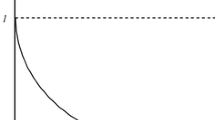Abstract
This article models the imperfect detection of tax evasion motivated by the existence of a corrupt tax administration. Consistent with previous literature, fines and audit probabilities both have a positive effect on compliance. Moreover, the model shows that they have a negative effect on the bribes paid to corrupt tax officials. More corruption decreases compliance levels, giving honest auditors incentives to work harder to detect evasion. Giving inspectors a share of the detected evasion (tax farming) makes auditors work harder; however, increasing their wages reduces their exerted effort to discover evasion. Higher compliance can as well be achieved by hiring more efficient inspectors.

Similar content being viewed by others
Notes
There exists the problem of moral hazard because the exerted effort cannot be observed. There exists the problem of adverse selection because not all potential tax inspectors can be identified as being honest or dishonest.
Lee (2001) presents a model where the amount of evasion found depends on the taxpayer’s self-insurance.
EURDP considers the possibility that indifference curves be kinked at the certainty point implying that reporting the true level of income can be optimal. The weighting function used in Bernasconi (1998) and obtained by Camerer and Ho (1994) is f(p) = 1-(1-p) γ /[p γ + (1-p) γ ] 1/γ, where γ = 0.56.
The Gauss code used to solve the model is available from the author upon request. The code uses the library NLSYS Version 3.1.2. The algorithm used is line search and the jacobian is calculated using forward difference.
References
Allingham, M., & Sandmo, A. (1972). Income Tax Evasion: A Theoretical Analysis. Journal of Public Economics, 1(3–4), 323–338.
Andreoni, J., Erard, B., & Feinstein, J. (1998). Tax Compliance. Journal of Economic Literature, 36(2), 818–860.
Bernasconi, M. (1998). Tax Evasion and Orders of Risk Aversion. Journal of Public Economics, 67(1), 123–134.
Bilotkach, V. (2006). A Tax Evasion—Bribery Game: Experimental Evidence from Ukraine. The European Journal of Comparative Economics, 3(1), 31–49.
Camerer, C. F., & Ho, T. H. (1994). Violations of the Betweenness Axioms and Nonlinearity in Probability. Journal of Risk and Uncertainty, 8(2), 167–196.
Chander, P., & Wilde, L. (1992). Corruption in Tax Administration. Journal of Public Economics, 49(3), 333–349.
Chu, C. Y. (1990). A Model of Income Tax Evasion with Venal Tax Officials—The Case of Taiwan. Public Finance, 45(3), 392–408.
Epstein L.G. (1992), “Behavior under Risk: Recent Developments in Theory and Applications” In: J.J. Laffont (ed), Advances in Economic Theory: Sixth World Congress of the Econometric Society (2), Cambridge University Press, pp. 1–63.
Esteller-Moré, A. (2004), “Tax Evasion in Interrelated Taxes”, Institut d’Economia de Barcelona. Working Paper 2004/2.
Feinstein, J. S. (1991). An Econometric Analysis of Income Tax Evasion and Its Detection. The Rand Journal of Economics, 22(1), 14–35.
Goerke, L. (2008). Bureaucratic Corruption and Profit Tax Evasion. Economics of Governance, 9(2), 177–196.
Hindriks, J., Keen, M., & Muthoo, A. (1999). Corruption, Extortion and Evasion. Journal of Public Economics, 74(3), 395–430.
Jain, A. (2001). Corruption: A Review. Journal of Economic Surveys, 15(1), 71–121.
Karni, E. and D. Schmeidler (1990), “Utility Theory with Uncertainty” in W. Hildenbrand and H. Sonnenschein (eds), Handbook of Mathematical Economics (4), North-Holland, pp. 1763–1831.
Lee, K. (2001). Tax Evasion and Self-insurance. Journal of Public Economics, 81(1), 73–81.
Sanyal, A., Gang, I., & Goswami, O. (2000). Corruption, Tax Evasion and the Laffer Curve. Public Choice, 105(1–2), 61–78.
Slemrod, J. and S. Yitzhaki (2002), “Tax Avoidance, Evasion and Administration” in A. Auerbach and M. Feldstein (eds), Handbook of Public Economics (22), Elsevier Science B.V., pp. 1423–1470.
Tanzi, V. and H.R. Davoodi (2001), “Corruption, Growth, and Public Finances” in K.J. Arvind (ed), Political Economy of Corruption, Routledge, pp. 89–110.
Vasina, P. A. (2003). Optimal Tax Enforcement with Imperfect Tax Payers and Inspectors. Computational Mathematics and Modeling, 14(3), 309–318.
Wane, W. (2000), “Tax Evasion, Corruption, and the Remuneration of Heterogeneous Inspectors”, World Bank Policy Research Working Paper No. 2394.
Yitzhaki, S. (1974). Income Tax Evasion: A Note. Journal of Public Economics, 3(3), 201–202.
Acknowledgments
The author thanks Morris Coats, Timothy Gronberg, Carlos Oyarzun, William F. Shughart II, John Straub and Leon Taylor for their comments. An earlier version of the paper was presented at the Southern Economics Association Meetings and at the Midwest Economics Association Meetings.
Author information
Authors and Affiliations
Corresponding author
Appendix
Appendix
From the Implicit Function Theorem: \( \partial D/\partial b = - \frac{{\partial G/\partial b}}{{\partial G/\partial D}} \), \( \partial D/\partial {a_h} = - \frac{{\partial G/\partial {a_h}}}{{\partial G/\partial D}} \), and \( \partial D/\partial {a_c} = - \frac{{\partial G/\partial {a_c}}}{{\partial G/\partial D}} \). G is given in Eq. 9 and
Rights and permissions
About this article
Cite this article
Escobari, D. Imperfect Detection of Tax Evasion in a Corrupt Tax Administration. Public Organiz Rev 12, 317–330 (2012). https://doi.org/10.1007/s11115-011-0172-5
Published:
Issue Date:
DOI: https://doi.org/10.1007/s11115-011-0172-5




